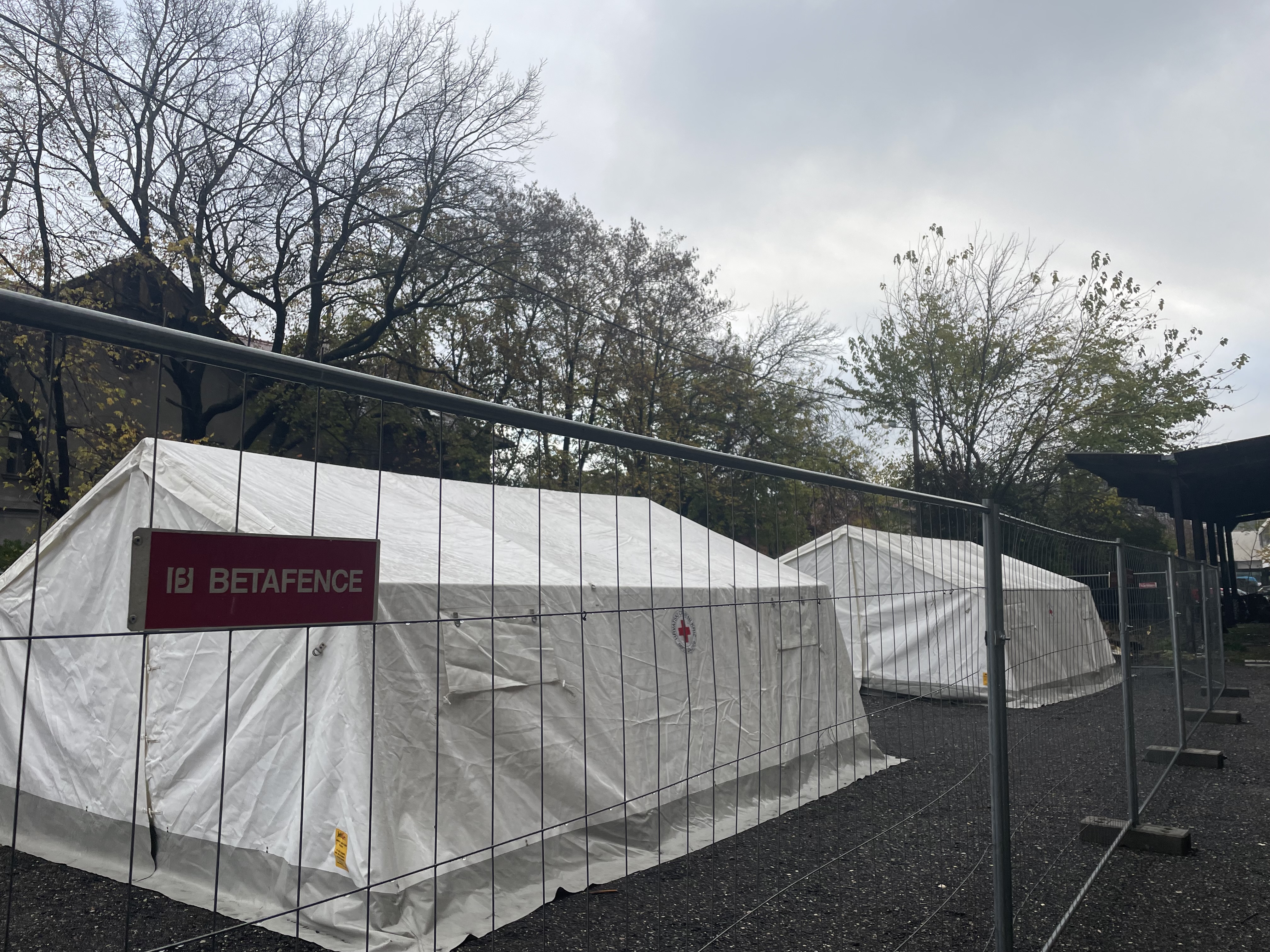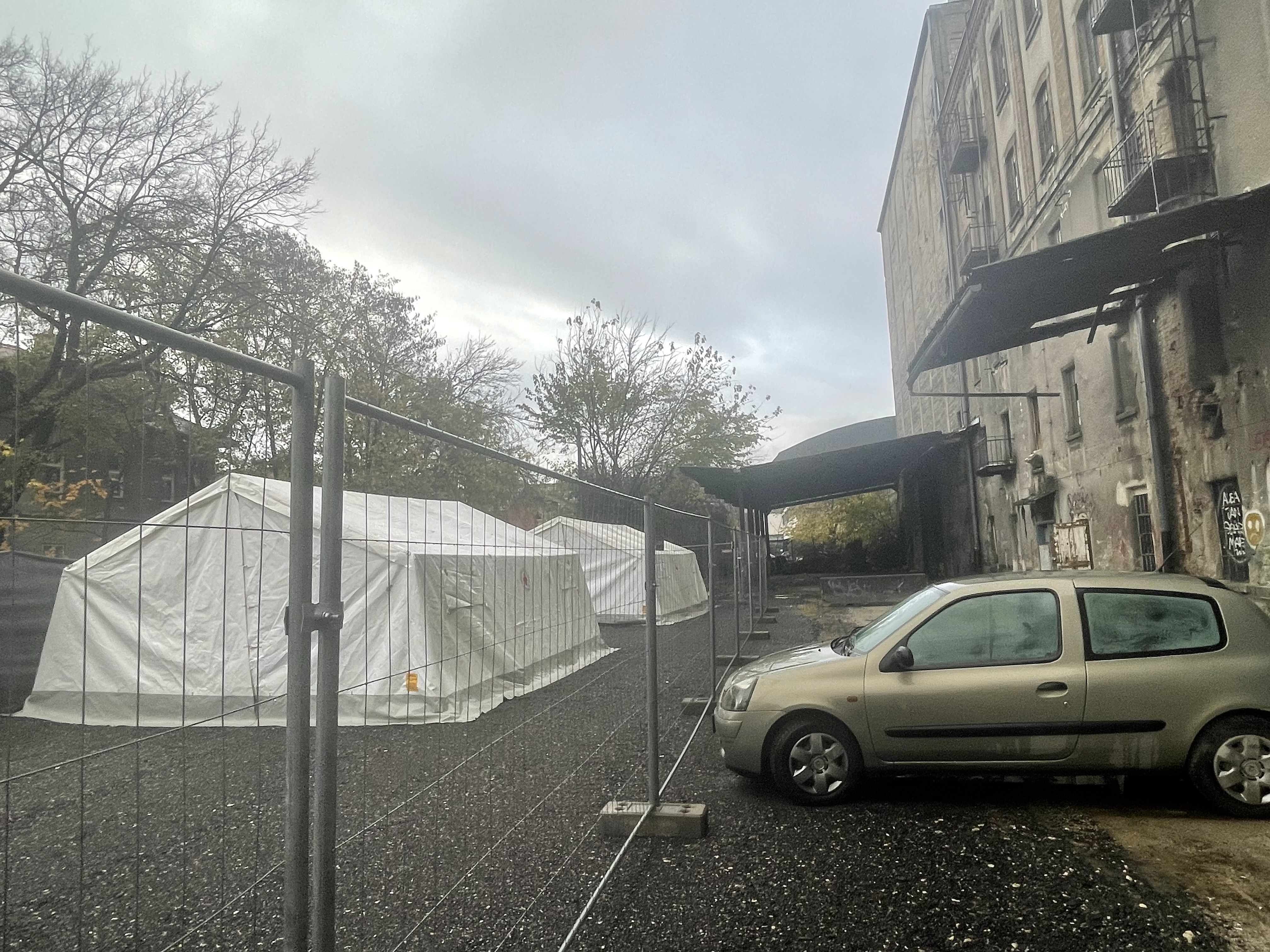Paromlin
In the spring of 2022, after five years of systematic expulsions and pushbacks at the Croatian borders (e.g., Davies et al. 2023), a significantly larger number of people on the move began passing through the city of Zagreb and other places in Croatia located on the Balkan migration route. In the fall of 2022, the facilitation of transit had already taken on humanitarian-securitarian contours, including a self-organized humanitarian point in Rijeka, raids at the main railway station in Zagreb, and a humanitarian station in front of the former Paromlin (steam mill) factory in Zagreb.
As a place for short stays and a boarding station for trains heading towards Rijeka and areas near the Slovenian border, the space around the Zagreb railway station became a frequent transit and stopping point for people on the move. With a simultaneous increase in the number of “foreign workers,” tourists, and residents of the reception center for people who apply for international protection, Porin, who also frequently passed through the station or spent time in its immediate vicinity, the main railway station in the summer of 2022 gave the impression of a completely new urban center. It spatialized the harsh dichotomy between the image of a cosmopolitan, intercultural European Union and its policy of systematic illegalization and precarization of people from the Global South attempting to migrate to Europe by various routes.
In contrast to the reaction of state institutions, local residents, and civil initiatives to the refugee corridor in 2015 and 2016, the increased transit in 2022 was not characterized by the standardized format of care and control such as refugee camps and securitarian-humanitarian corridors. Instead, Croatian authorities issued return decisions in large numbers, soon to be called seven days paper, and checked whether racially profiled people on the move in trains, buses, and public places had these documents with them and detaining them if they did not (Pozniak 2023). Many were forced to use abandoned spaces near the main railway station as overnight shelters, such as the building of Zagrebačka Banka, the Paromlin factory, or the space of the former store near the station, known as Diskont.
Despite the fact that the green-left coalition Možemo is in power in Zagreb, city services responded a whole six months after the start of the mass issuing of return decisions and the increased presence of people near the main railway station. At the end of November 2022, just a few days before the opening of the Advent Zagreb event, the Zagreb city administration opened a humanitarian station near Paromlin. Although Paromlin, as an industrial architectural monument, is listed as a protected cultural good in the Register of Cultural Goods, it is a highly neglected object that, due to its dilapidated appearance and potential danger, evokes fear and discomfort among many passersby. After being damaged in a fire in 1988, the Paromlin building partially collapsed due to what the media reported as “prolonged neglect and lack of maintenance.” Following this, “without the approval of the Ministry of Culture, the former city administration, led by Milan Bandić, demolished the chimney, which was also protected.” According to the latest data, the building is set to undergo a complete renovation costing 80 million euros as part of the project “City Library of the City of Zagreb and socio-cultural center at the Paromlin location.” This was confirmed by the deputy mayor in a promotional video, stating that “after decades of neglect of the most representative city space [including the Paromlin factory building and the Zagrebačka Bank building], this city administration has taken on its refurbishment.”
In addition to being an unprotected space where the façade could easily collapse, the establishment of humanitarian infrastructure in the shadows of the city’s hustle and bustle—at a location very close to the city center and the railway station, yet hidden from public view—right at the time of the Christmas festival, suggests that it was not only a humanitarian measure but also an effort to remove or redirect migrants to less visible parts of the city center (Pozniak 2023: 256).
The latter is confirmed by the deputy mayor’s remarks at the station’s opening, stating that “the location was chosen very carefully, away from the main city thoroughfares, yet close to the main influx of migrants.” This is further supported by the fact that, in the fall of that year, the police began turning people away from King Tomislav Square, known as Tomislavac. Previously, not only had their presence there been tacitly allowed, but by issuing return orders (and, according to field data, directing people on the move to the main railway station), the police had facilitated their movement and stay on public spaces near the Zagreb station. Additionally, the preparations for the ice rink on Tomislavac as part of the Christmas festivities in November 2022, and the opening of the humanitarian station at the end of the same month, suggest that the space was being cleared to ensure the Advent festival could take place without any issues (Pozniak 2023).
The humanitarian station consisted of two heated tents – one for gathering migrants and another where food was distributed – and a sanitary container. It did not offer overnight accommodation but was designed, according to the representatives of the City Red Cross Society, as a place for short-term, daytime relief. It was surrounded by a wire fence, and as Red Cross workers told my colleagues and me, two police officers usually stood at the entrance, along with a plainclothes policeman in a car parked nearby. Although the station was primarily intended for individuals in Zagreb with return orders, we were told their documents were not checked and that the station welcomed everyone, including local homeless people. However, volunteers, researchers, journalists, and other visitors needed special permission to enter. I described my somewhat bizarre experience of entering the station with colleagues in a field note:
First, as we approached the entrance, a police officer greeted us with his annoyed honking from his black Golf after we had passed through the entrance gate of the station. He then got out of the car, waving his hands excitedly and insisting that we could not enter (asking where we were going, if we had permission, etc.). A security guard, who emerged from his car parked in another position, asked if everything was okay, behaving somewhat protectively towards us. The police officer went to fetch the Red Cross workers, and after a brief discussion, because we were not on the list, the Red Cross people called their boss and finally got approval to let us in (13 December 2022).
Later, we learned that the police officers were on a break, which is why there was no one at the entrance at that moment. We also discovered from our conversations that the City Red Cross, which managed the station, had two cots available for emergencies, as well as additional beds and tents in storage that could be used if requested by the city administration. Clothing was not distributed due to logistical problems and issues with scabies, but also because it was “not requested.” Food was distributed once a day, with 150 meals being served. The number of visitors per day was measured by the number of food portions distributed, with the highest number of daily visitors being 170. However, it is important to note that sometimes the same people probably came for food multiple times a day. Additionally, the Red Cross sometimes had dry food packages to go, which consisted of canned fish, pâté, and sometimes bread. The daily operating costs of the station were around 10,000 HRK (heating the tents, water, food, etc.), and medical assistance was provided by the nearby health center in Kruge.
During our conversation, we were under the impression that our interlocutors felt it was important to emphasize that the (dehumanizing) conditions at the station were not (solely) the responsibility of the Red Cross but also of the city administration, and that they were performing their duties according to their respective responsibilities and jurisdictions. When we asked about the collapse risk of the façade of the building in front of which the tents were erected, they admitted that the situation was far from ideal but emphasized that structural engineers had checked the condition of the Paromlin building and approved their work at that location. Ultimately, the station was closed after two months of operation, on 26 January 2023, due to, according to official data, a significantly lower number of visitors since the beginning of the year and Croatia’s entry into the Schengen Area. However, the situation in Rijeka indicated that the number of people passing through Croatia had not decreased; rather, people on the move were no longer passing through Zagreb as frequently.
Due to its environment and location in the city of Zagreb, the scarce content of humanitarian aid, and the timing of its opening just before the Christmas festival, the Paromlin humanitarian station can be considered a reflection of the intersection of several policies. On one hand, Croatian authorities, primarily the Ministry of the Interior, sought to control the movement of migrants through temporal management techniques in the form of seven-day papers (see Pozniak 2023). On the other hand, the Zagreb city administration, which aimed to provide support to people on the move in principle, responded six months later, just before the start of Advent. It relied on short-term infrastructure and an externalized public care system, i.e., humanitarian actors and temporary, mostly unsustainable, and ineffectual humanitarian solutions. Thus, the humanitarian station, opened in the shadow of the post-industrial ruination of Paromlin, mirrored the seemingly contradictory but essentially complementary relationship between the tactical policy of the left-green city administration and the state migration management regime. Their ultimate goal was not to ensure long-term social support for people in transit, but quite the opposite, the discreet humanitarian-temporal facilitation of their departure from Croatian territory.
18/12/2023
Literature
Davies, Thom, Arshad Isakjee and Jelena Obradovic-Wochnik. 2023. “Epistemic Borderwork. Violent Pushbacks, Refugees, and the Politics of Knowledge at the EU Border”. Annals of the American Association of Geographers 113/1: 169-188.
Pozniak, Romana. 2023. “Temporalnost humanitarne skrbi. Politike upravljanja vremenom u režimu migracija”. Narodna umjetnost 60/2: 243-262.


